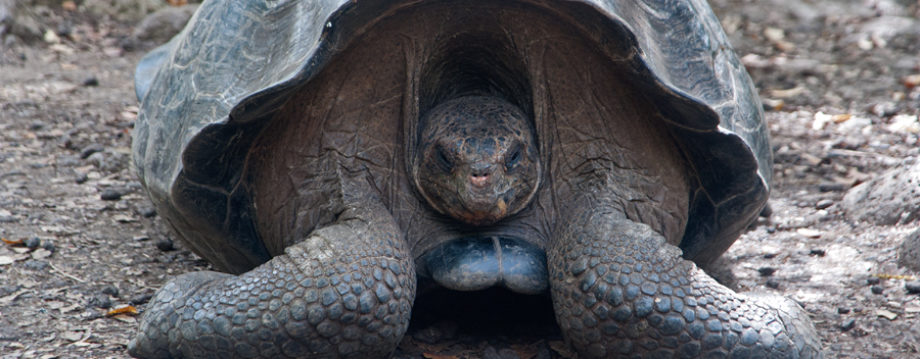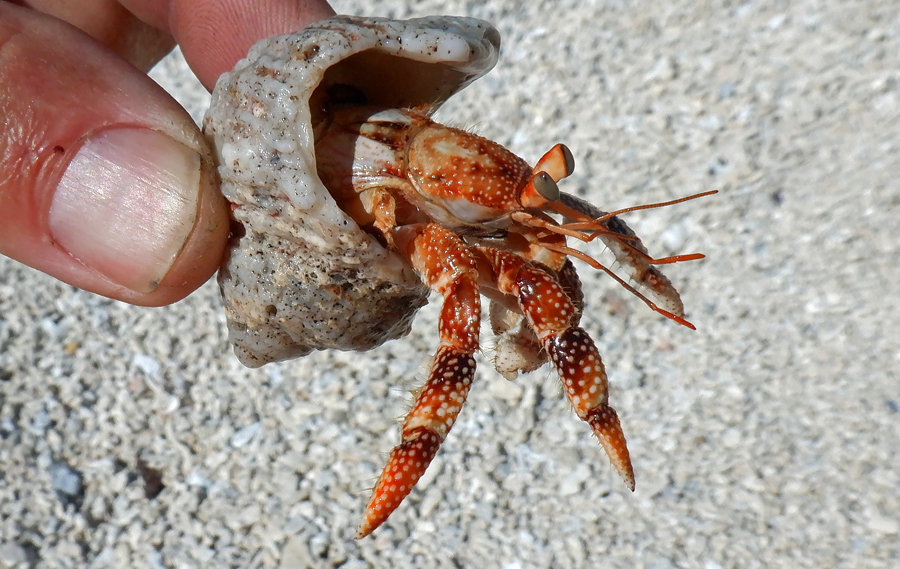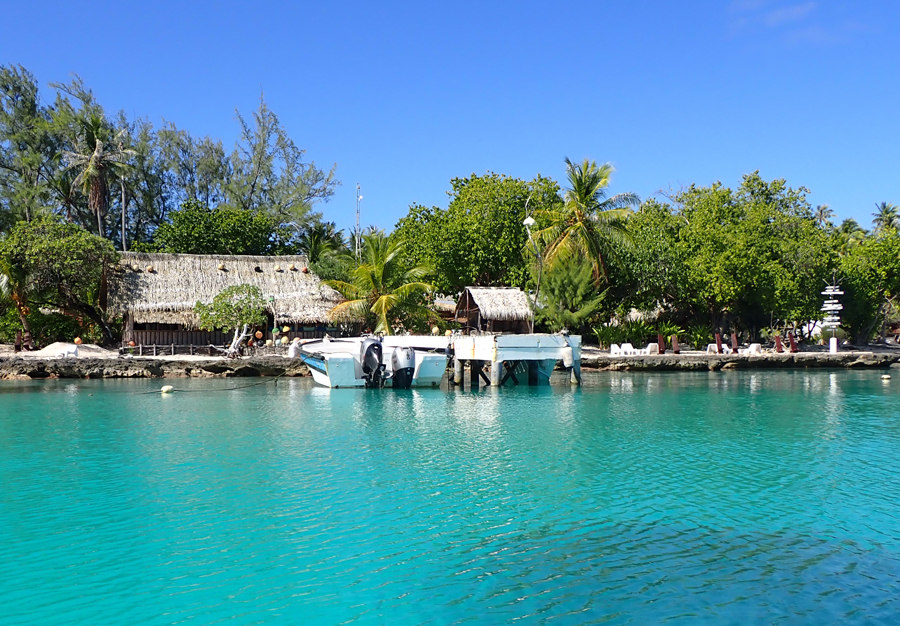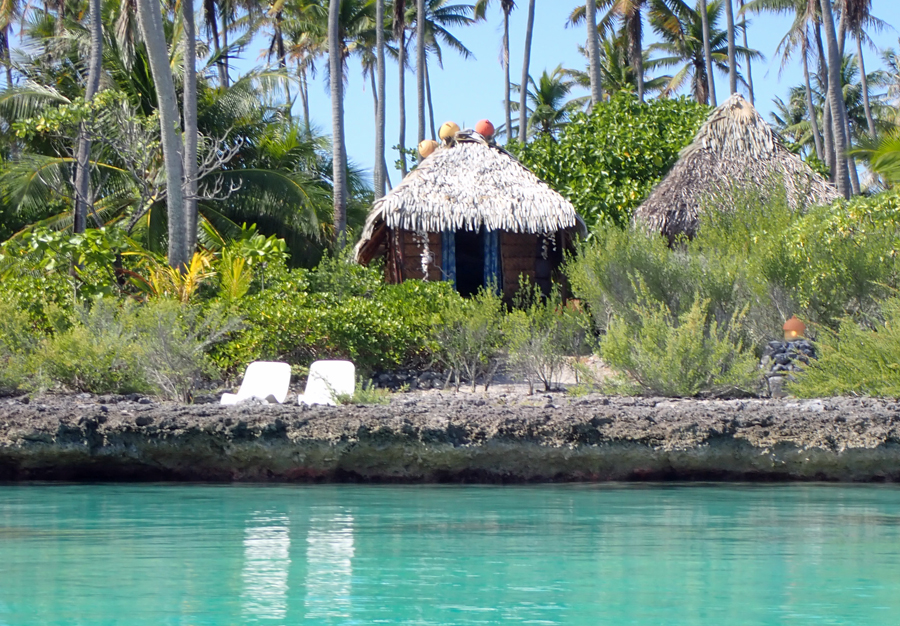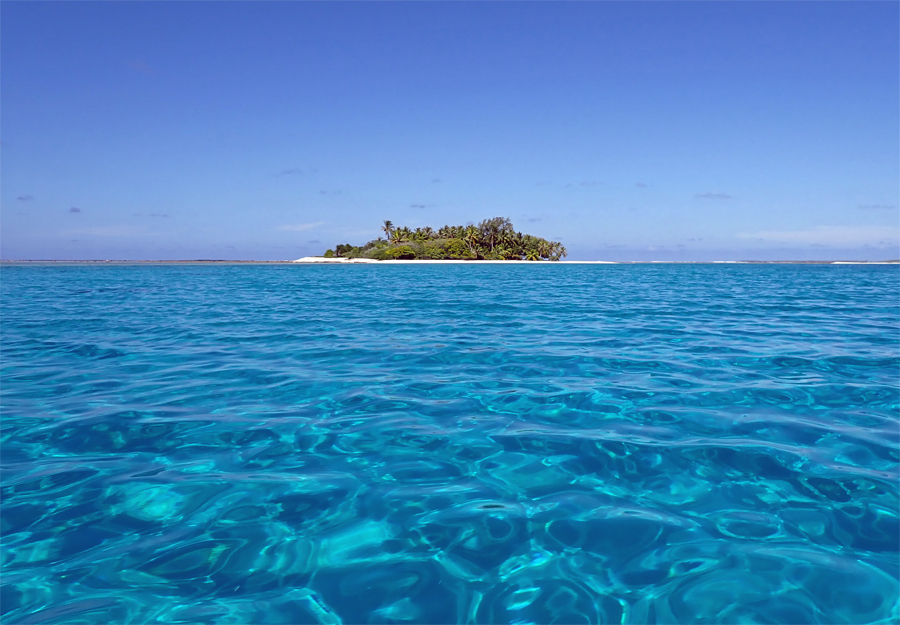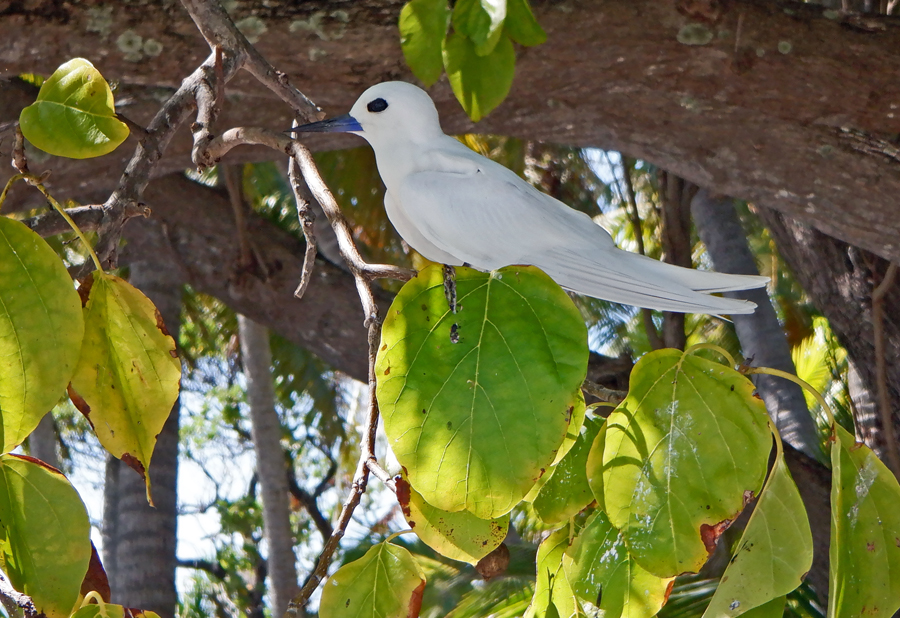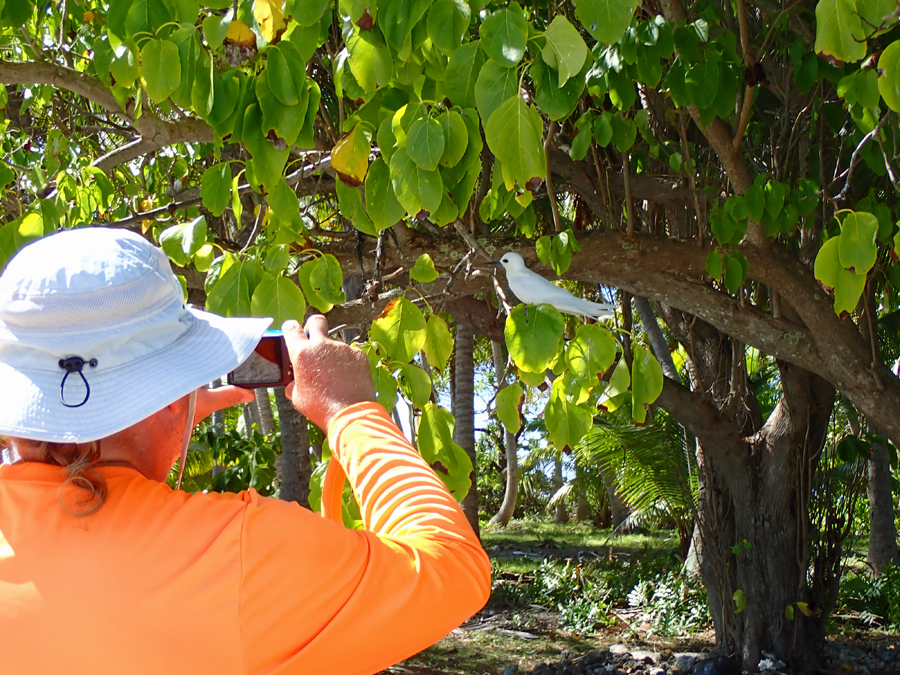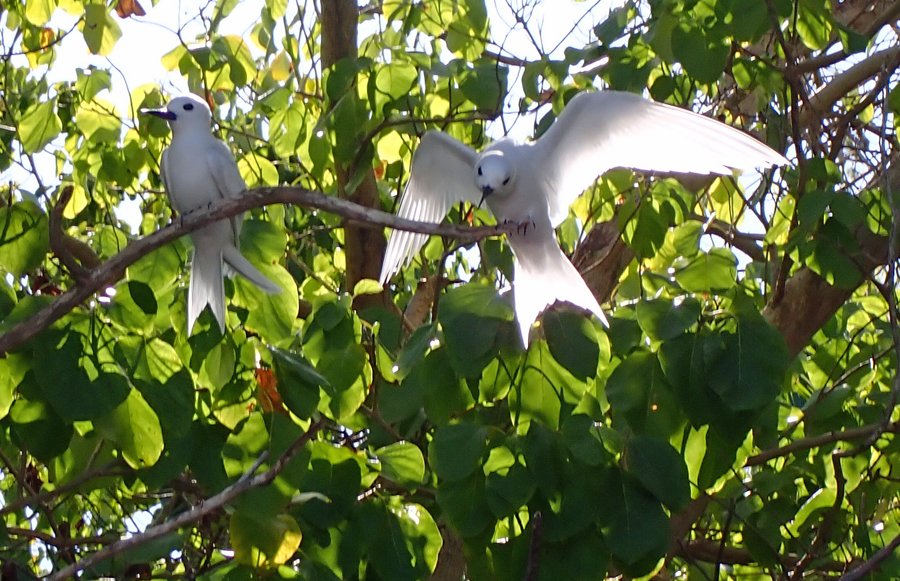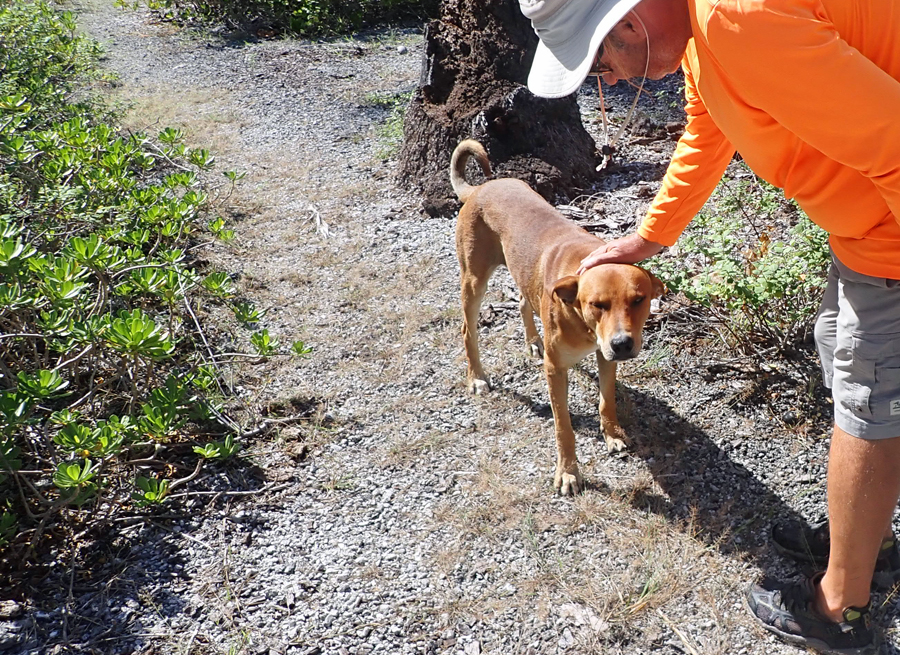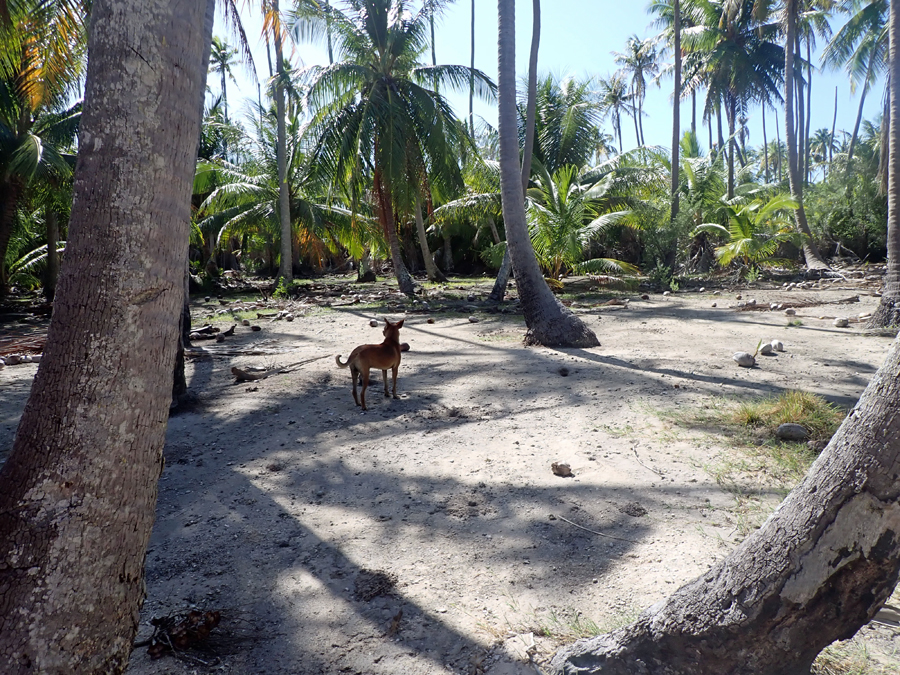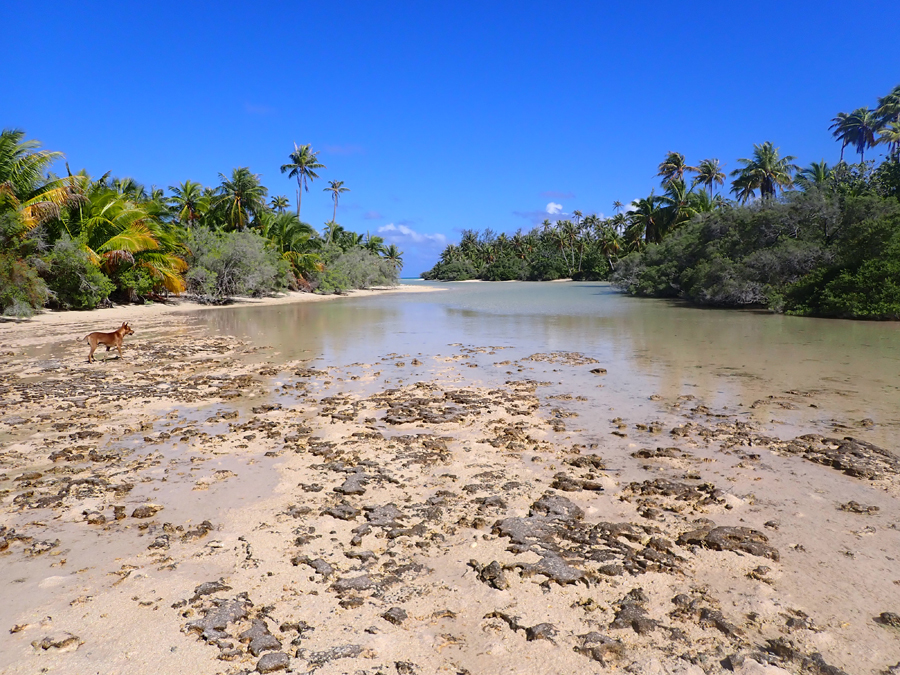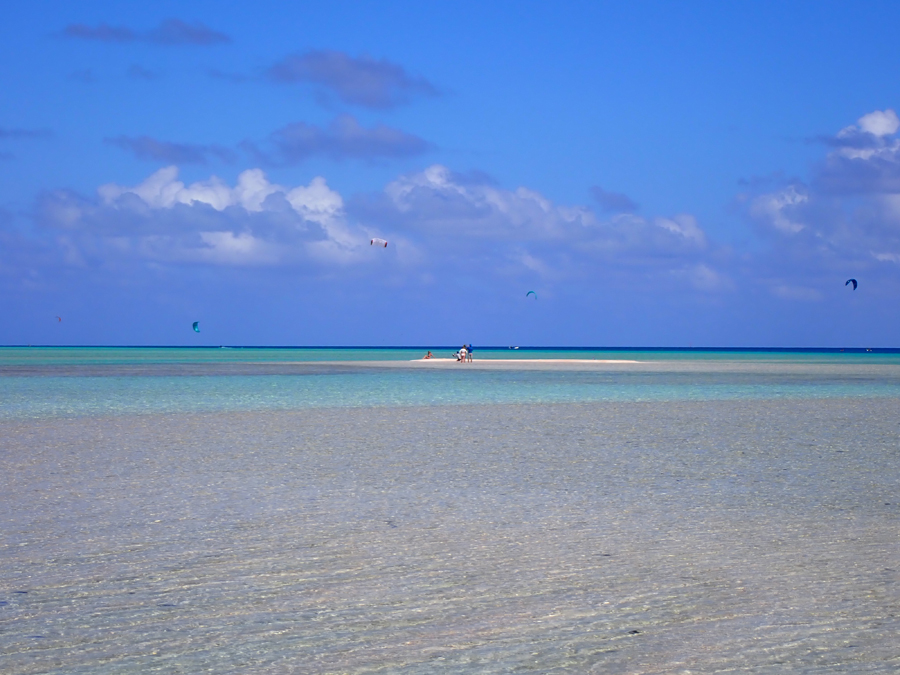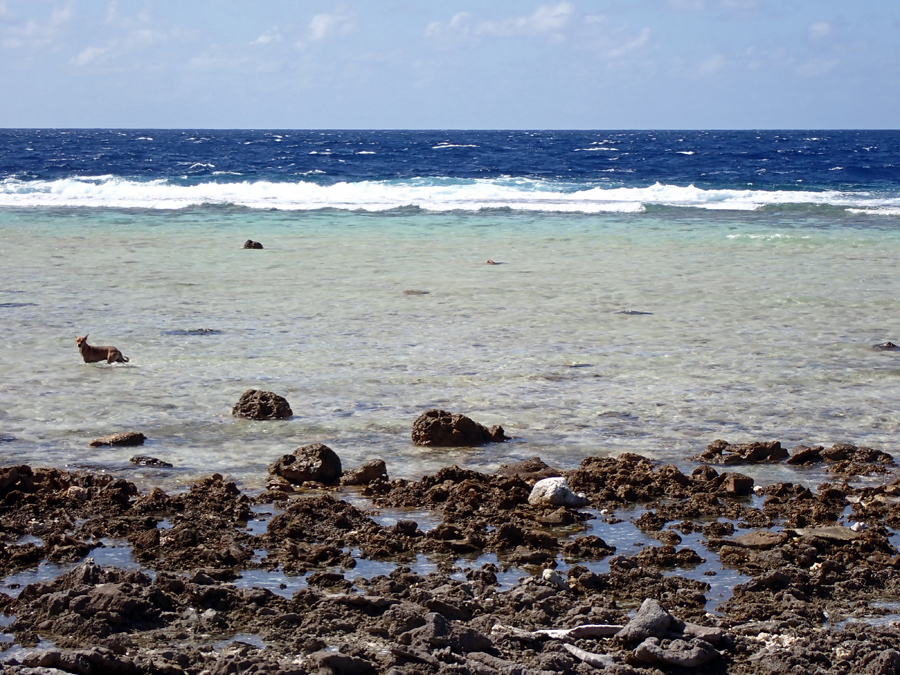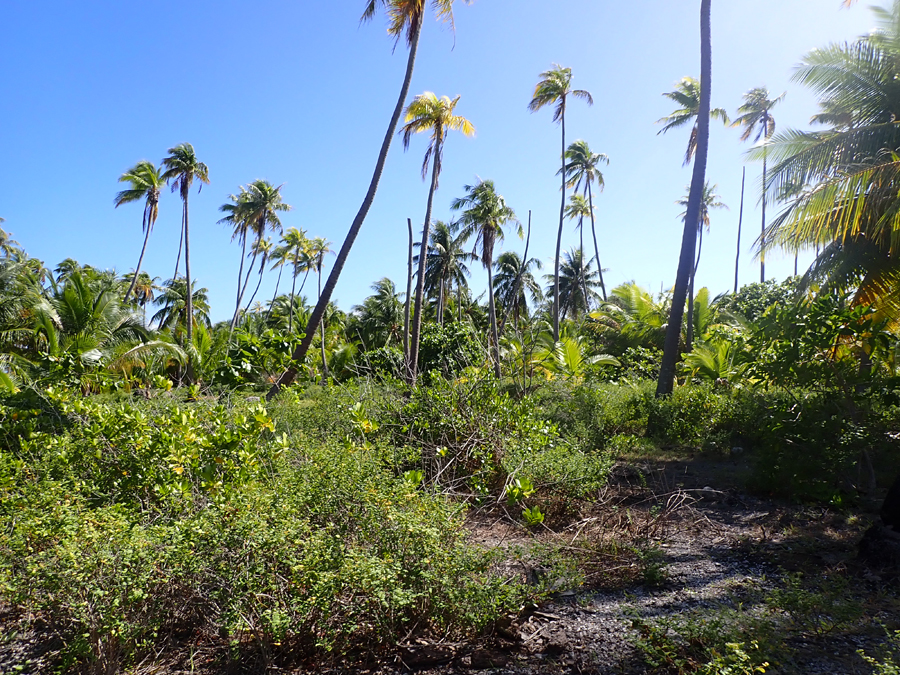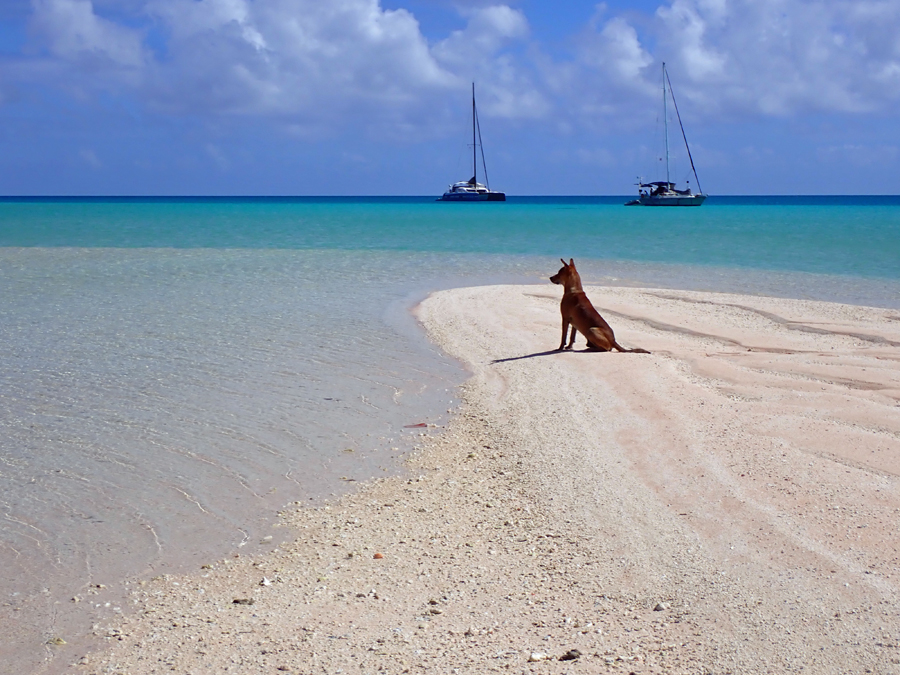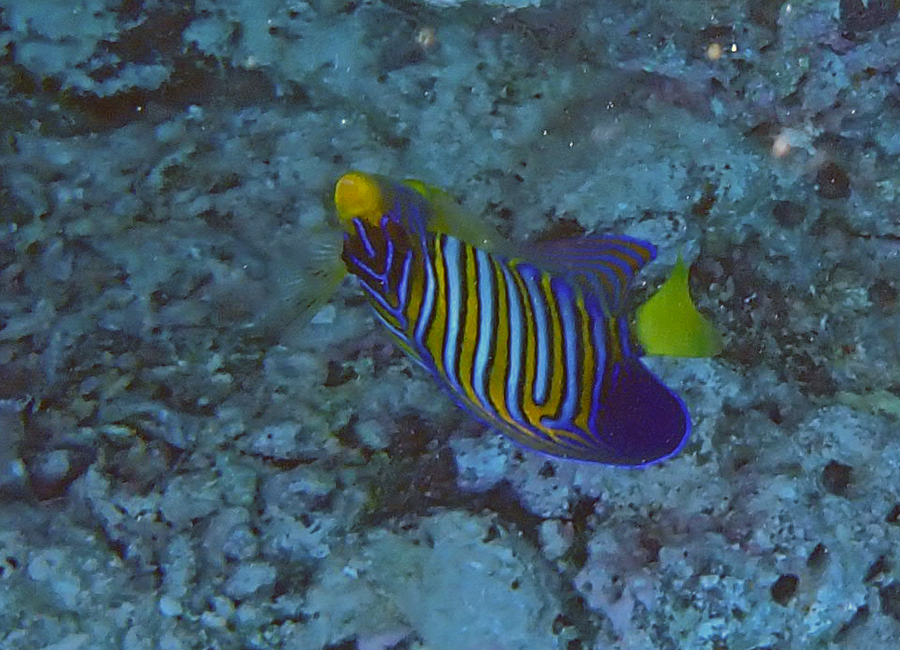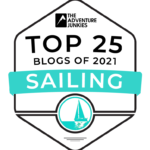I am picking up where we left off in Part I.
Here is a video I wanted to attach to Part I but, with the ailing hamster situation, it wasn’t possible. We have moved a little and believe it or not we have 4G service. Or perhaps the hamster has been replaced with gerbils, four of them: 4G (get it?). When you think about this, it’s amazing since we are on such a small island with less than 900 people.
The video shows what I was trying to explain. I am standing on the very outer edge of the atoll. The deep blue water is hundreds of meters deep. The ridge I’m on is barely above sea level and my feet are getting wet. The tidal pools are about 6 cm deep. Then, the land rises a little bit and there is black lava rock. Beyond this is the lush greenery of the atoll. If you don’t see the video below, click here.
Pensions
Isabella and Santiago told us about a pension just up the island a little bit that will shuttle their guest about for a small fee. A pension is a low-budget hotel. I use the word hotel cautiously. Pensions are bare-bones places to stay. Often times there’s a main building with food, showers, and bathrooms. The guests sleep in houses or huts with palm roofs, hammocks are often used instead of beds, and unglazed openings for windows and doors. The luxury ones might have a mosquito net over the hammock. Isabella and Santiago suggested we take the pension’s dive boat to the South Pass for a snorkel adventure. I have to laugh about how they described the location of the pension. They told us, at nighttime it is the only light we’ll see if we look in the general north direction.
We easily found the Raimiti pension based on Isabella and Santiago’s directions. Raimiti is a small compound with a couple of boat docks. We tied our dinghy to the dock and before I could walk down the dock I am met by a man who looks a little bit miffed I am there. I explain we are looking to book a snorkel trip and ask if this is the right place. It turns out it is the right place and we agree on a price and Friday morning. He agrees to pick us up at the boat at 9 am. We do most of this with limited language skills and I can’t help but wonder if I have the day, time, and money correct.
I love this. From the top of page on the Raimiti web site:
Can’t do without noise, lights, modernism, night outings in nightclubs, plastic, concrete, the smells of the city, air conditioning, television?
Do you like the superficial, the sophisticated, the organized, planned holidays, without surprises?
Don’t read on, it’s not for you!!!
Friday morning comes and the weather is perfect. The lagoon is flat and the skies are sunny. In typical island-time fashion, 9 am comes and goes. At 9:15, I begin to wonder if something was lost in our conversation and if I have it wrong. No money has exchanged hands yet so it’s not like we’re out if they forget us. At about 9:20 we see their boat coming toward us. The skipper comes to the stern of our boat and we successfully manage to transfer ourselves and our snorkel gear to the boat. He speaks very little English but has an infectious smile.
There is another couple on the boat. We say hello and explain our French is very limited. We didn’t want them to think us rude by not talking. It turns out, their English is better than our French and we can exchange a few pleasantries. They are from Tahiti and are spending a few days at the pension. I ask if it is a vacation and they tell me it’s a long weekend. They are spending the morning on a small island called Motu Kokakoka. We drop them off and joke that we will not come back to get them.
The small islands are called motus. A motu can be an island inside the atoll. But, more often they are a part of the atoll circle where the ocean has eroded a cut making small islands. Most are owned by someone. Even the uninhabited ones are usually owned. So if visiting a motu, a person needs to be respectful that it is someone’s private land. Meaning that you don’t just willy-nilly pick up what you find there and claim ownership by hauling it off.
We did our snorkel at the south pass and it was awesome. I will post the details of the south pass in a future post since we plan to go back again. On the way back, we picked up the French Tahitians we earlier marooned. We thought it might be fun to explore a motu and this one is pretty close to us. The next day we took off in our dinghy. What we found was surprising.
Attacked By a Remora at Kokakoka
The first surprise: no sand. From the distance, there appears to be a white sandy beach surrounding the motu. This is in fact made up of small bits of broken coral and is quite rocky. The coral is bleached by the sun and rounded by the ocean. It isn’t sharp and makes a sort of clinking sound as we walk on it. The second surprise: a ton of birds.
At first glimpse, I spotted one bird sitting on a lower branch of a tree I was walking toward. It didn’t fly away. They’re not afraid of us. I guess they don’t see many humans and really have no fear. As we enter the canopy under the trees and start to look up, we realize there are hundreds of birds. We later identify the birds as White Terns.
Regarding the structure on the motu; it’s difficult to know if it is in the process of being improved upon or falling apart. There is a cistern to collect water from the makeshift roof. There’s even an open-air toilet set over what appears to be a septic tank. I can’t help but wonder if the place is listed on AirBnB as a rustic cabin on a private island – only $500 per night.
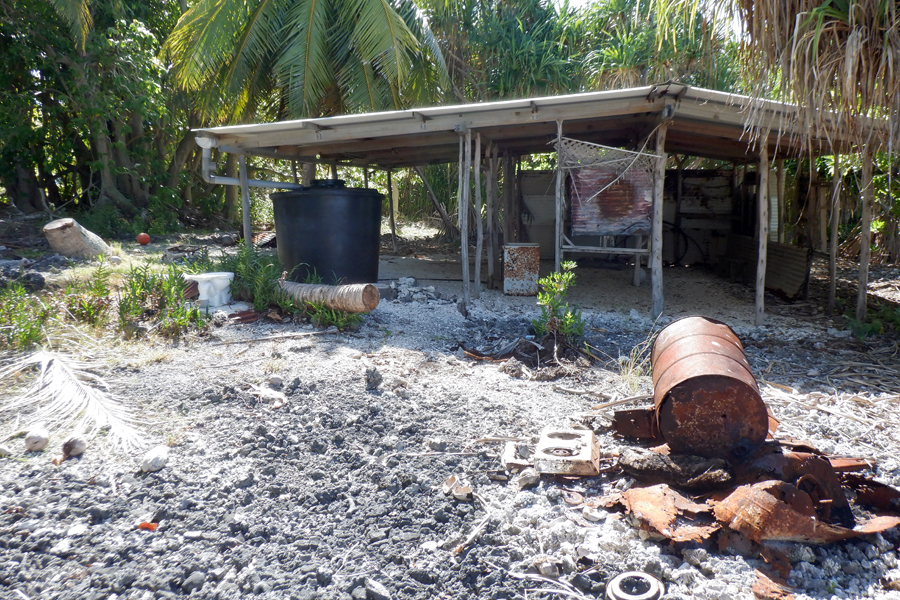
The black tank is to collect rainwater from the roof. Just to the left of the water tank notice the outdoor toilet
After about 30 minutes, we explored the entire island and decide to go snorkeling about the coral heads in the shallow surrounding waters. This is when things start to go wrong. We decide to swim the deep water first on the east side and then perhaps work our way around to the west side. The south side is very shallow – mostly tidal pools all the way to the reef edge and the ocean.
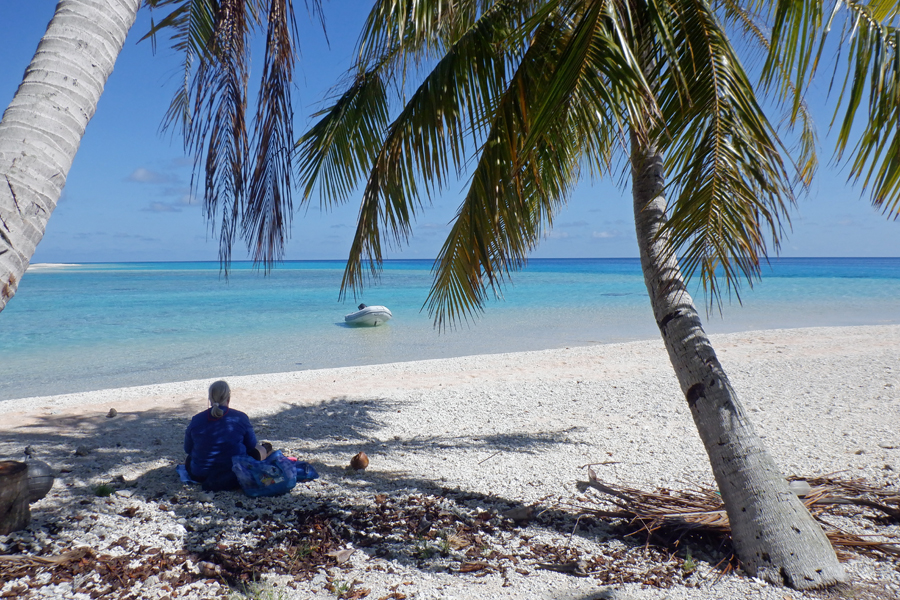
I return from my trek to the back side of the motu to find Cindy taking a break before we go snorkeling
We are in the water for less than 10 minutes and a remora decides it wants to attach itself to one of us. It’s a persistent little bugger and no matter how much splashing and kicking we do to drive it away, it still won’t leave us alone.
Remoras are the fish you see in nature shows that are attached to sharks. They can get quite large. We have a couple under Cream Puff right now that are about 2 feet long. We’ve read that they have very powerful suckers and once attached can scratch skin if removed. The commentary in the nature show will tell you the remoras are harmless and the sharks don’t mind them hitching a free ride. But as Cindy pointed out, sharks don’t talk and nobody really knows if the sharks mind, or not.
For about 10 minutes, we tried to scare the remora away but to no avail. Cindy got smart. When it was trying to attach to me, she suggested we swim in different directions toward shore. The remora stuck with me the entire way (get it?). Only when I was fully out of the water did the darn thing finally swim away. Cindy was already out further down the beach and had firmly decided this was not a spot she wished to explore any further. The only way she was getting back into the water was to wade to the dinghy and leave. I’m in agreement completely. So, we headed back to Cream Puff for lunch.
We Find a Guide Dog

We beach our dinghy just north of the little restaurant at the tip of the atoll to go for a long walk
Basically, we are dog people and always have been. For most of our marriage and in our youth we had dogs. I think dogs have a sense of whether someone is a dog person, or not. They just seem to know. Also, dogs can instantly bond to a person for no particular reason. I’m going to sidetrack here for just a second to put a smile on your face.
We had a dog called Boots. She was a rust-colored Cavalier King Charles Spaniel mix with white feet. Boots absolutely adored me. If there was an opportunity to be next to me, in an instant she was there. Cindy could be feeding her cheese, she loved cheese. If I tapped my lap, she’d abandon the cheese, run over to me, and hop up into my chair making herself comfortable. Have you ever known a dog to run away from food?
A few years later, we adopted an Australian Sheppard mix from the dog pound. Since she was homeless we dubbed her Hobo. It didn’t take long for Hobo to pick Cindy as the person to bond to. I used to office from the house a lot in my job and Hobo would sleep under my desk in my upstairs office in the front of our house. All of a sudden her ear would prick up. Then, she’d stand up quickly and trot toward my office door and run downstairs making a hell of a whining racket at the garage door. About 2 minutes later, I’d see Cindy turn into the driveway.
How Hobo knew she was coming was beyond me. It wasn’t a time thing since Cindy had no set schedule and would come and go from work through the day. Hobo would then follow Cindy about the house. I never did figure out what triggered Hobo to know Cindy was almost home. She didn’t do this when I arrived home and she was with Cindy.
Okay, back to our guide dog. We decided to go for a long walk on the beach, around the peninsular of the island and to the outer side of the atoll. Finding a nice sandy spot, we beached the dinghy and tied it to a tree. We tie it on the beach since neither one of us checked if the tide was coming in or out. As we near the last structure on this end of the atoll a dog came up from behind and hit my hand with its nose. Dog people will immediately know this means friendship.
If you are approached by a dog and you’re not sure, offer the back of your hand extending your arm toward the dog. Every dog knows this as a sign of friendship. Most will sniff the back of your hand and then the tail wags. Sometimes, like this dog, they will make the first move. I guess this is part of doggie DNA since even this French Polynesian dog on a remote atoll knew to do this.
I have no idea who’s dog this is but, it decided to take us for a walk. There are not a lot of people here so there aren’t trails to follow. It is possible to walk for a little while then find yourself at an impasse due to dense shrubbery and having to return the way you came. This was not the case for us. Our new best friend seemed to understand where we wanted to go and led the way. He’d trot off a little bit in front of us, stop, and look back as if to ask, “you coming?”
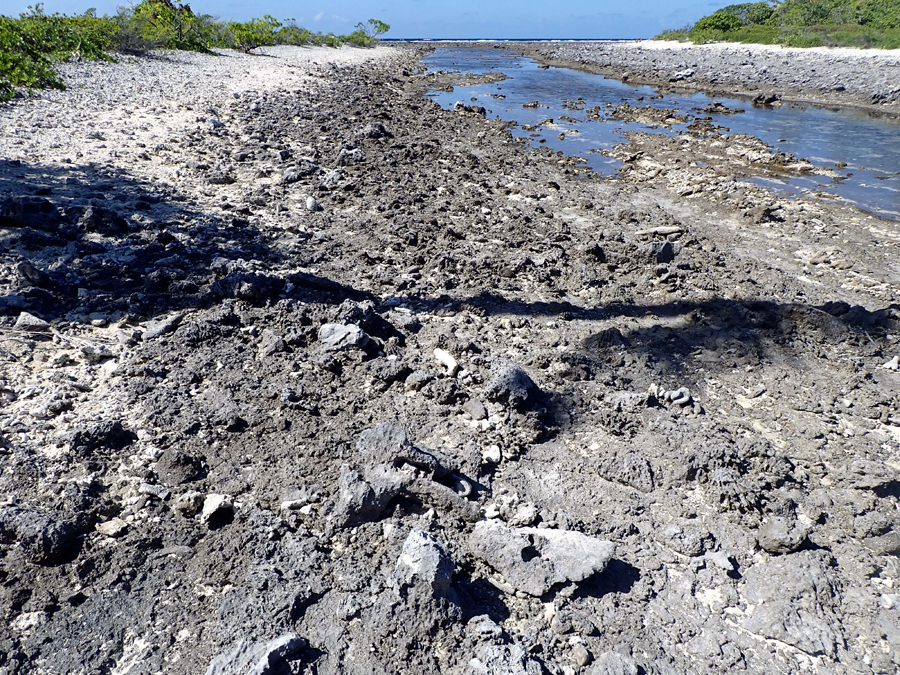
We follow the lava flow bed to the other side of the island. Walking on this is really hard. It’s very easy to twist an ankle. The dog has gone way ahead at this point.
As we followed him, he led us around a lagoon over an old lava flow and to the other side of the island. Once there, I found a rock to sit on and took in the isolation, fresh breeze, and smell of the ocean. Cindy found a rock about 10 meters away and also took a seat doing the same. My new dog friend also decided this was the right thing to do and took time to smell the roses.
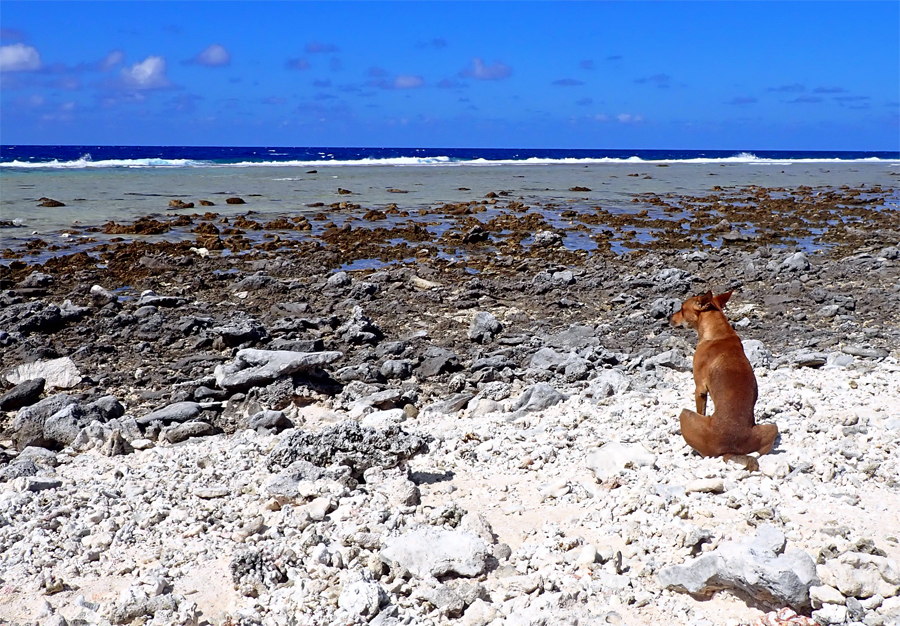
As I sit on my rock, the dog decides to sit just in front of me and takes in the same view. We stayed like this for about 15 minutes. Just taking it all in.
On the way back, our guide dog abandoned us. I guess he figured he’d shown us the way there and assumed we were capable of finding our way back. He was wrong. We got a little lost. This time, instead of walking around the lagoon, we decided to wade through it. It was just above the knees in the middle. On the other side, we found ourselves on a small beach with no way out. It was surrounded by dense shrubbery. Stepping over tons of coconuts palm fronds, avoiding prickly bushes and potholes, we found a clearing. But, at this point, we are turned around.
We can hear the ocean roaring outside of the atoll and since our dinghy is on the beach inside, it made sense to walk trying to keep the noise of the ocean at our back. This got us only so far. Then we’d find ourselves unable to move forward because of the shrubbery and have to backtrack a little bit to find another way. Where’s the dog when we need him?
The island isn’t very wide and so there’s no fear of us disappearing forever. After a few minutes, we find ourselves emerging from the forest at the exact spot where we’d beached our dinghy. It looked like we really knew what we were doing. We couldn’t have come out at a better spot if we’d tried.
A couple of days later, we are walking down the beach again. And like before, I suddenly feel a wet nose on my left hand. It’s our unfaithful guide dog who abandoned us on the far side of the island. He’s come to take us for another walk. Except this time we don’t fall prey to his innocent follow-me demeanor. we were just walking along the beach to the tip of this part of the atoll. The dog beat us there and I snapped this picture.
Bommies or Potatoes
It seems some Europeans use the term potatoes and the Americans use bommies to describe these almost islands. From Google Earth, bommies can be seen scattered throughout the atolls. These are reefs within the reef and present a huge concern when navigating the boat inside the atoll. Many rise to a height just below the surface and can be spotted due to the change in water color using a good pair of polarized sunglasses to minimize the glare. The ones we are most concerned about lay about 2 meters below the surface and are harder to see. We can’t sail over these. We need 2.2 meters to float over them. Hitting a bommies will most definitely cause damage to the keel or hull of Cream Puff.
Located near our anchorage are a couple of bommies that are marked with navigational markers making them easy to avoid. Most are not marked and some are not charted. We decided to take our dinghy and swim around the bommies and find out if it had much marine life. Fish like rocks.
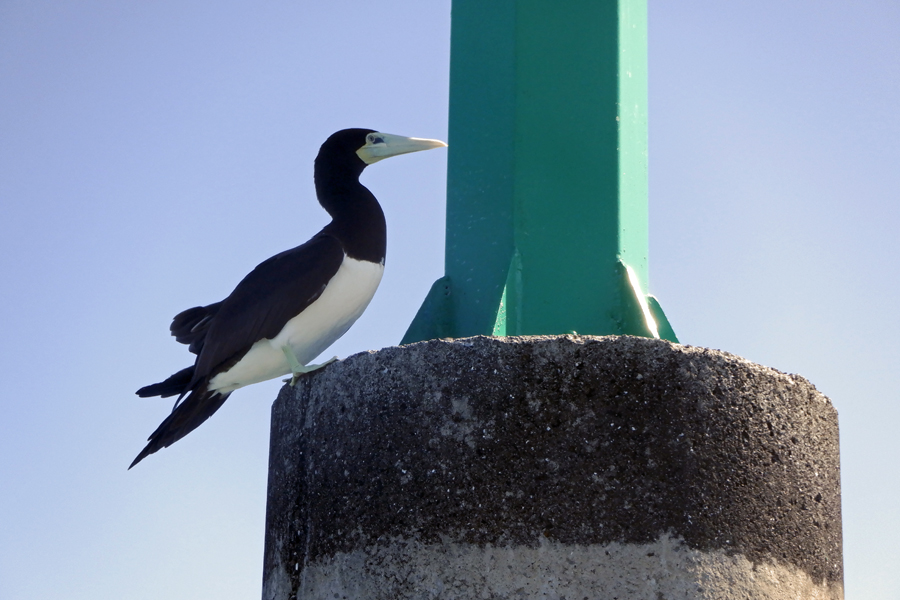
I managed to sneak up on this boobie while I was in the water to get a close up shot of it sitting on the base of the bommie navigation marker
The water is very clear and looking in from the dinghy we didn’t see much in the way of fish. We can usually easily spot the blue and yellow fish as they brightly reflect in the sunlight. Regardless, we decided to jump in anyway. We found a small sandy spot and dropped our dinghy anchor. In my finest snorkel attire I rolled off the side of the dinghy with camera in hand. When I pop up Cindy asks, “Well, is it worth it?” I see a few fish, but not many. So I tell her it’s worth taking a look but not to get too excited. I was wrong.
I started swimming anti-clockwise around the bommie – that’s the sort of person I am. It’s normal for me to go against the grain. Cindy came in a few minutes behind me a started a clockwise swim. I saw a few large groupers and a handful of colorful fish. I pop my head up to check on Cindy. We often stay together keeping a close eye on one another when in the water. We’re in the middle of nowhere and you can’t just call 911 or 999 if something goes wrong. I see Cindy waving for me to come to her. At first, I wonder if something is wrong.
Something isn’t wrong. It’s excitement that is calling me over. It seems the entire population of marine life has congregated at her end of the bommie. Unlike other places we snorkeled, the fish are totally unmindful of our presence. They make very little effort to swim away unless we get really close. We both snap some pictures of fish we haven’t seen before to later identify using our fish ID cards. One of the prettiest fish that is new to us is a Royal (Regal) Angelfish. This fish is shy and Cindy’s pic is the best we can do before it disappears into a cave with the rock.
I shot this quick video at the bommie to give an idea of how much marine life there is in these atolls. Click here if you don’t see it below.
What’s next?
We are running a little low on fuel and need to head up to the town about a 5-hour sail away inside the atoll. We are not in dire straits as I don’t like our diesel to go much below 1/3 of a tank. Like most cautious sailors we like to have a reserve. Online, using our slower than slow internet, we try to find out refueling options.
Good information about things like fueling is hard to come by in our world. Let me explain. Many of the resources we try to use are full of outdated material and postings by fellow cruisers. We read there is a fuel dock where we can take fuel straight from the pump. However, other cruisers say it is necessary to buy fuel at the gas station and transport it in jerry cans to the boat using our dinghy. And yet, other cruisers also post fuel must be ordered by the barrel and the delivery is via the weekly supply ship. These sailors go on to say a hand pump can be borrowed to transfer the fuel to jerrycans and transported to the boat using the dinghy. So what is the situation? We’ll update you in the next post after we find out in part III assuming we still have 4 gerbil internet.
